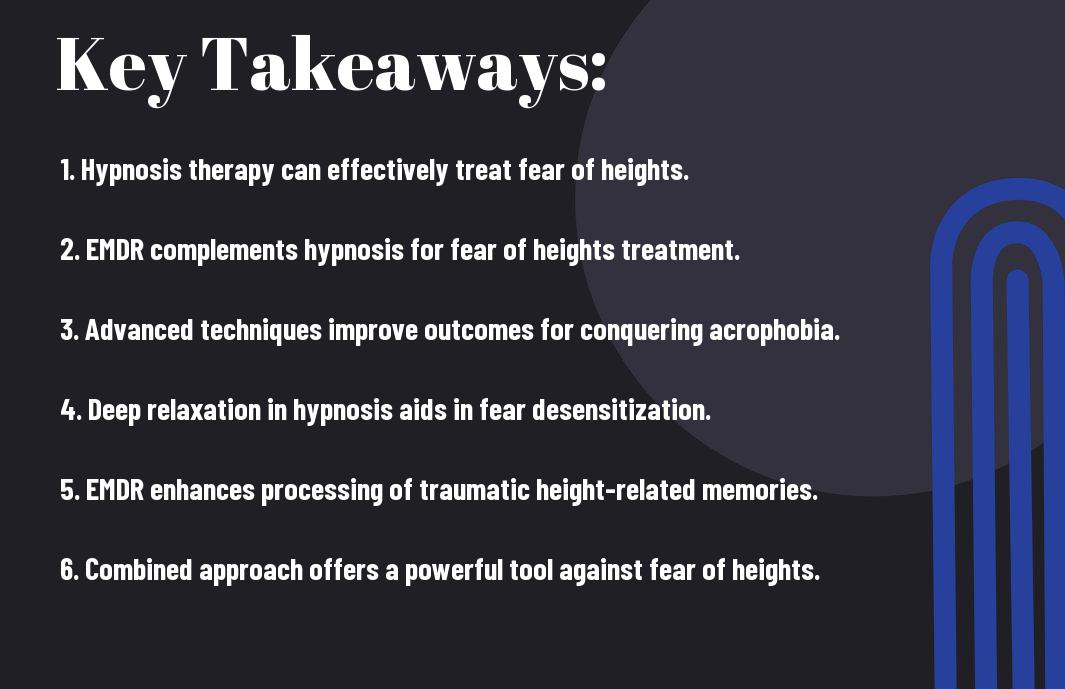Advanced hypnosis therapy and EMDR for the fear of heights
With advanced hypnosis therapy and EMDR, conquering the fear of heights is not just a possibility, but a reality. Hypnosis therapy research deep into the subconscious, rewiring thought patterns to eliminate debilitating fears, while EMDR targets past experiences, facilitating rapid healing. These powerful techniques offer effective solutions for those grappling with a fear that can hinder daily activities and limit experiences. Say goodbye to paralyzing fear and embrace a life free from the constraints of height-related anxiety with the transformative powers of hypnosis therapy and EMDR.
Key Takeaways:
- Hypnosis therapy can effectively help individuals overcome the fear of heights by accessing the subconscious mind and addressing the root cause of the phobia.
- During EMDR therapy, eye movements and other forms of bilateral stimulation can help reprocess traumatic memories associated with heights, leading to emotional healing and reduced anxiety.
- Combining advanced hypnosis therapy with EMDR can enhance the effectiveness of treatment for the fear of heights by targeting multiple aspects of the phobia simultaneously.
- Therapists skilled in hypnosis and EMDR can provide individuals with personalized and holistic treatment to address their specific fears and triggers related to heights.
- Through hypnosis and EMDR sessions, individuals can learn to manage anxiety and build resilience when faced with height-related situations, leading to greater confidence and freedom.

The Prevalence of Acrophobia
Definition and Symptoms
Symptoms of acrophobia, the fear of heights, can manifest in various ways. Individuals with acrophobia may experience intense anxiety or panic when exposed to heights, even if they are in a safe and secure environment. Physical symptoms such as dizziness, sweating, trembling, and a rapid heartbeat are common reactions to the fear of heights. Additionally, individuals with acrophobia may feel a sense of impending doom or fear of losing control when confronted with heights.
Statistics and Demographics
With acrophobia affecting approximately 5% of the global population, it is considered one of the most common phobias. This fear can impact individuals of all ages, genders, and backgrounds, with some experiencing mild discomfort and others facing debilitating anxiety at the mere thought of being at a height. Women are more likely to develop acrophobia than men, and the onset of this phobia typically occurs in early adulthood.
Plus, acrophobia can significantly limit a person’s daily activities and quality of life if left untreated. The fear of heights can prevent individuals from enjoying certain recreational activities, pursuing certain career paths, or even performing simple tasks like climbing a ladder or looking out of a window on an upper floor.
The Science Behind Fear of Heights
It is intriguing to examine the science behind the fear of heights. Understanding how our brains function and respond to height-related stimuli can give us valuable insights into this common phobia.
Brain Function and Response
The brain plays a crucial role in processing fear, especially regarding heights. When exposed to heights, the amygdala, the part of the brain responsible for processing emotions, triggers a fear response. This activation can lead to intense feelings of anxiety, panic, and the urge to retreat from the height.
Evolutionary and Psychological Factors
- Evolutionary Roots: Evolutionary psychology suggests that the fear of heights may have developed as a survival mechanism to protect our ancestors from falling and injuring themselves.
- Psychological Conditioning: Past negative experiences or learned behaviours can also contribute to developing a fear of heights.
Recognizing the underlying factors contributing to the fear of heights is necessary in addressing and overcoming this phobia.
Brain: The intricate network processes fear and height-related stimuli, triggering intense emotional responses.
Evolutionary and Psychological Factors
- Evolutionary: The fear of heights likely evolved as a survival instinct to protect early humans from danger.
- Psychological: Past experiences and learned behaviours can further reinforce this fear, leading to a heightened sense of anxiety in high places.
Advanced Hypnosis Therapy for Acrophobia
After identifying the specific phobia of heights, advanced hypnosis therapy can be a powerful tool in addressing acrophobia. Here are some key points to understand:
-
- Principles and Techniques
| Principles | Techniques |
| Empowering the subconscious mind | Positive affirmations, visualization |
| Addressing root causes of fear | Regression therapy, inner child work |
For Induction Methods and Deepening Relaxation
-
-
- After establishing rapport with the client, the hypnotherapist can use various induction methods like progressive relaxation or guided imagery to induce a state of deep relaxation.
-
- Principles
- Creating a safe space for the client to relax
-
-
Any hypnotherapy session for acrophobia should focus on inducing a deep state of relaxation to access the subconscious mind and work on rewiring negative thought patterns associated with heights.
-
-
- Suggestion and Visualization
- Using positive imagery and suggestions to reframe the fear of heights
-
Relaxation
-
- With the guidance of a skilled hypnotherapist, clients can learn to relax deeply and visualize themselves in situations involving heights without experiencing fear. This process helps in desensitizing the phobic response and creating new associations with elevated spaces. By utilizing advanced hypnosis techniques tailored to treat acrophobia, individuals can experience remarkable shifts in their perception of heights. It is vital to combine hypnosis therapy with EMDR for a comprehensive approach to address deep-rooted fears effectively.

Eye Movement Desensitization and Reprocessing (EMDR)
Once again, another advanced therapy technique that has shown great promise in treating phobias, including the fear of heights, is Eye Movement Desensitization and Reprocessing (EMDR). This therapy, initially developed to treat trauma-related disorders, has been increasingly used to address various anxiety and phobia issues.
History and Development
Reprocessing EMDR was developed by Francine Shapiro in the late 1980s, and since then, it has gained recognition for its effectiveness in reducing the emotional distress associated with traumatic memories. By incorporating elements of cognitive-behavioural therapy with bilateral stimulation, such as eye movements, tapping, or sounds, EMDR aims to help individuals process distressing experiences and their underlying beliefs more adaptively.
Mechanisms and Benefits
Reprocessing The primary goal of EMDR is to help individuals reprocess traumatic memories by engaging in bilateral stimulation while focusing on the distressing material. This process is believed to help the brain reorganize and integrate the traumatic memories, leading to a reduction in emotional distress and the associated symptoms. The benefits of EMDR include the potential for rapid symptom reduction, long-lasting results, and the ability to target specific memories or beliefs contributing to the fear of heights.
The bilateral stimulation used in EMDR is thought to engage both hemispheres of the brain, facilitating the processing and integration of the traumatic memories. This dual-focus approach allows individuals to access and reprocess the memories more effectively, leading to emotional healing and a shift in the associated negative beliefs.
EMDR vs. Traditional Exposure Therapy
Movement When comparing EMDR to traditional exposure therapy for the fear of heights, EMDR offers a unique approach by targeting the underlying traumatic memories or beliefs contributing to the phobia. While exposure therapy involves gradual exposure to the feared stimulus, EMDR aims to address the root cause of the fear and reprocess it in a more direct and focused manner.
It is important to note that EMDR may be particularly beneficial for individuals who have a history of trauma or adverse experiences related to heights, as it allows for a deeper exploration and processing of these memories. Additionally, EMDR’s ability to target specific memories or beliefs associated with the fear of heights can lead to a more comprehensive and lasting resolution of the phobia.

Combining Hypnosis and EMDR for Optimal Results
Which is more effective for treating phobias, exposure therapy or EMDR? Fear of heights can be deeply rooted in the subconscious mind, making it challenging to address solely through traditional therapy methods. However, by combining hypnosis therapy with Eye Movement Desensitization and Reprocessing (EMDR), individuals can experience remarkable breakthroughs in overcoming their phobia. Hypnosis therapy can help uncover underlying fears and beliefs, while EMDR can assist in reprocessing traumatic memories associated with heights, leading to profound healing and transformation.
Integrating Techniques and Strategies
With a tailored approach that integrates hypnosis and EMDR, therapists can create a powerful treatment plan that addresses the fear of heights from multiple angles. This dual modality approach allows for a more comprehensive exploration of the subconscious mind and a targeted reprocessing of past experiences.
Addressing Trauma and Emotional Roots
Integrating hypnosis therapy and EMDR enables therapists to examine deep into the emotional roots and traumatic events that may have contributed to the fear of heights. By identifying and addressing these underlying factors, individuals can experience significant relief and begin to let go of their debilitating phobia.
Understanding the link between past trauma and present fears is crucial in the journey toward healing and freedom from the fear of heights. By combining hypnosis therapy and EMDR, individuals can process and release these emotional wounds, paving the way for a brighter, fear-free future.
Enhancing Self-Efficacy and Confidence
Self-efficacy and confidence are key components in overcoming the fear of heights. Through the integration of hypnosis therapy and EMDR, individuals can develop a stronger sense of self-assurance and empowerment. By rewiring negative thought patterns and beliefs, they can cultivate a positive mindset and approach heights with newfound courage.
Addressing the subconscious mind through hypnosis therapy and reprocessing traumatic memories with EMDR can lead to lasting changes in perception and behaviour, ultimately empowering individuals to conquer their fear of heights.
Overcoming Common Challenges and Obstacles
Building Trust and Rapport
The foundation of any successful hypnosis therapy and EMDR for the fear of heights treatment is building trust and rapport with the client. Allowing the client to feel comfortable, safe, and understood is crucial in creating a conducive environment for overcoming their fear. The therapist can achieve this by actively listening, showing empathy, and demonstrating genuine care for the client’s well-being.
Managing Resistance and Anxiety
With hypnosis therapy and EMDR, some clients may exhibit resistance or anxiety towards the treatment due to the nature of their fear of heights. The therapist should approach this with sensitivity and patience, helping the client understand that these reactions are normal and guiding them through relaxation techniques. Plus, using positive affirmations and visualization can aid in reducing resistance and anxiety, allowing the client to progress effectively in their treatment.
Dealing with Setbacks and Plateaus
Overcoming setbacks and plateaus is a common challenge in the journey of treating the fear of heights with hypnosis therapy and EMDR. Challenges such as relapses or feeling stuck can be addressed by revisiting previous successful sessions, adjusting the treatment plan if necessary, and providing continuous support and encouragement to the client. The key is to remind the client of their progress and empower them to overcome obstacles with resilience and determination.
Conclusion
Conclusively, advanced hypnosis therapy and Eye Movement Desensitization and Reprocessing (EMDR) have shown great promise in treating the fear of heights. These techniques offer a unique approach to addressing the root causes of this phobia, allowing individuals to overcome their fears and regain control over their lives. By harnessing the power of the mind and incorporating innovative therapeutic methods, individuals can experience profound changes and find relief from their fear of heights.

Through the use of hypnosis therapy and EMDR, individuals can confront their fears in a safe and controlled environment, enabling them to reframe negative perceptions and replace them with positive associations. As we continue to explore the potential of these advanced therapies, it becomes increasingly evident that they offer a valuable tool for individuals seeking to overcome their fear of heights and reclaim their sense of freedom and empowerment.
FAQ
Q: What is hypnosis therapy?
A: Hypnosis therapy is a therapeutic technique where a trained professional induces a state of deep relaxation and focused attention to help individuals access their subconscious mind and make positive changes in their thoughts, feelings, and behaviours.
Q: What is EMDR?
A: Eye Movement Desensitization and Reprocessing (EMDR) is a psychotherapy approach that helps individuals process traumatic memories and rewire negative beliefs by using bilateral stimulation such as eye movements, tapping, or sounds.
Q: How can hypnosis therapy help with the fear of heights?
A: Hypnosis therapy can help individuals overcome the fear of heights by accessing the subconscious mind and reprogramming the negative associations and beliefs related to heights, allowing them to feel calm, confident, and in control in high places.
How can EMDR benefit individuals with a fear of heights?
A: EMDR can benefit individuals with a fear of heights by helping them process and reframe past traumatic experiences or negative beliefs that contribute to their fear, allowing them to feel more empowered and less fearful in high places.
Q: What are the advantages of combining hypnosis therapy and EMDR for the fear of heights?
A: By combining hypnosis therapy and EMDR for the fear of heights, individuals can experience a synergistic effect where they can address both the conscious and subconscious aspects of their fear, leading to quicker and more profound results in overcoming their fear and gaining a sense of freedom and empowerment.
The Official Instagram profile of Mind Spirit Body Hypnosis therapy and advanced hypnotherapy sessions.
About the author: Award-winning Fanis Makrigiannis of Mind Spirit Body Hypnosis therapy is a certified Hypnotherapist and Master Practitioner of Neuro-linguistic Programming with the American Board of Hypnotherapy. Proudly serving Durham Region, The Greater Toronto Area, Peel Region, Ontario, Canada, and the United States of America via Zoom meetings.




